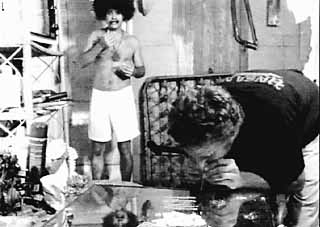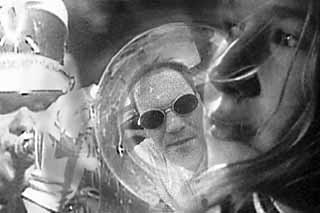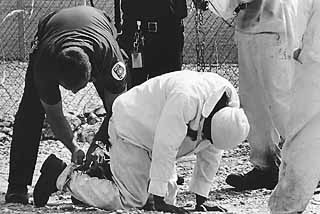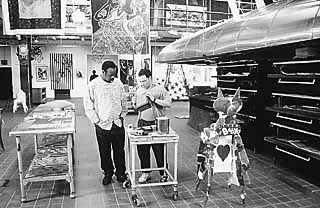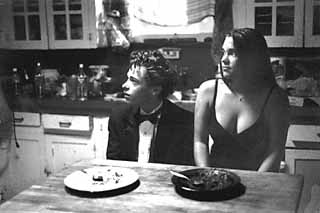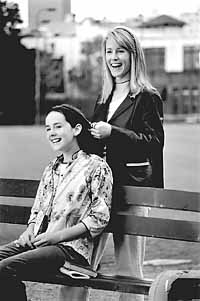Spotlights
Fri., March 12, 1999
ROCK OPERA
|
Rock Opera |
In a perfect world, Roche Laboratories would have paid Austinite Bob Ray to produce this genuinely warped, pharmacologically oriented tale of gutterpunk sniping and Lone Star drug running. That company's signature slacker sleep aid, Rohypnol, makes myriad appearances and fills the role of McGuffin as various characters scramble to score, scam, and snooze, all while blissfully bombed. Sure, dirtweed makes an appearance, but in the pantheon of cinematic drug abuse, roofies have it all over simple, old-fashioned marijuana. Of course, pot isn't likely to render you droolingly comatose or as woefully stupid as Toe (Jerry Don Clark), the skaggy star of Ray's drug opera. Toe, guitarist for the local band PigPoke and an occasional drug dealer, wants so badly to go on tour with his band (if only to play "to a different four people every night") that he backstabs a series of friends, steals their drug turf, gets the bejeesus beaten out of him by a psycho dealer, and ends up with a whole lot of blood on his hands, not all of which is his own.
At once sublimely accurate in its portrayal of the creepier end of the Austin music scene (infamous local band the Fuckemos are all over the place) and scathingly hilarious, Ray's film is a spot-on quasi-parody of the day-to-day existence of struggling Austin musicians and their wayward ways.
"I started writing a script a long time ago and then realized partway through it that I didn't have the money to blow up 16 trailer parks so I started writing another script about something I knew more about and with which I could utilize my resources. Being involved in bands and zines and pirate radio shows here in Austin kind of led me down this alley that ended up being Rock Opera. It's all about what this guy does to get some appreciation for his band." The way the character of Toe -- think Shaggy with a different kind of Scooby Snack -- tries to garner that appreciation is as double-dealingly backhanded as any of John Waters' lowlifes, and frequently funnier.
Austinites will have a blast spotting locations, cameos, and the assorted band members and hangers-on that populate Ray's film, while outsiders will recognize the cracked music scene template as S.O.P. for any scene in the country. It could be Seattle if not for the presence of Shiner Bock (fewer clams, too). So is this a biography of the Austin scene? "Sort of," says Ray. "A lot of pieces of the film are based on stories that I've heard or witnessed or been told by drunken folk around town, but then there's a lot of it that's fictionalized as well. A lot of people are playing exaggerated versions of themselves, like Russell Porter from the Fuckemos, who plays a guy named Ross who's in the Fuckemos." Finally, cinema as a mirror that doubles as a dope tray. -- Marc Savlov
Sat, Mar 13, Dobie 2, midnight; Tue, Mar 16, Dobie 2, midnight; Wed, Mar 17, Dobie 2, midnight
BAND
|
|
Have you always wondered what those red-faced school band kids were doing at the parking lot at 6am? Or, like filmmaker Duane Conder, were you one of them? Conder's sweet, gratifying documentary has plenty of reverence for that uniquely American experience called band, and plenty of insight for those of us outside the tight, hand-holding circle, who never understood the long hours and the pride, and for that reason made those students answer to a slew of demeaning names -- "band freaks" as it was in my school, "band queers" in Conder's experience. In tracing the Spirit of Waxahachie Band along their 1997 season, Waxahachie alum Conder finds not only beautiful music and friendship, but also a family in which a stern but loving father pushes the group to excellence, in which waifish, eye-rolling freshman mature over four years into young men and women, leaders who do not blink at their sometimes tremendous responsibility. And in probing all that, Conder also captures the lingering images: the look of despair when failure seems imminent, the faces scrunched up in concentration under a flood of lights, the laughter and swelling pride that comes from a victory shared.
Not that much has changed in the small town 50 miles south of Dallas since Conder himself graduated from his high school band in 1984. And 15 years later, after a failed music career and a disappointing experience in college band, Conder returns to the field, camera in hand, ready to erase those bad memories. Throughout the season, he documents the team's work on the ambitious Peterloo, as well as their foray along the thorny road known as UIL competition. Into the next year, as Conder's focus becomes tangled in hours of footage, he wrestles to go on with the project, a despair which eventually brings him to therapy sessions, which he films and uses as a counterpoint to the band's voyage. "Struggling to dig deeper, I realized the band had the same problems in '97 that I had [editing] in '98," he explains.
Of course, both parties did persevere, and for Conder, what he documents is the reason why this continues to be a rite of passage for millions of American teens, that pivotal moment in which music, teamwork, precision, and pride all interweave. But perhaps the greatest accomplishment is that Conder finally achieves the elusive thing he's been chasing so long: closure. "When I think about Waxahachie now, I think about what I did in 1997, instead of what I did in '84." And like those small town kids swallowed up underneath the Friday night lights, Conder admits to his own share of fear and trembling as he prepares to premiere his first film at the SXSW Festival, since, as of this week, "only about five people have seen the final cut." He's not hoping for too much: "I just hope more than 12 people show up." -- Sarah Hepola
Fri, Mar 13, Dobie 2, 8pm; Wed, Mar 17, Alamo Drafthouse, 5:30pm; Fri, Mar 19, Alamo Drafthouse, 4:30pm
AMERICAN CHAIN GANG
|
|
With the nationwide prison population swelling and pressure and to "get tough on crime" rising, states are adopting various approaches toward making prison more of a deterrent than just "three hots and a cot." Among the more draconian measures to be tried in recent years has been Alabama's decision in 1995 to reinstate the chain gang. By the next year, Arizona became the first state to try all-female chain gangs. After seeing a Life magazine photo exposé on the subject, filmmaker Xackery Irving went to Alabama to see firsthand what life on a l990s chain gang was actually like. The result is a sober, impartial documentary that examines chain gangs (and prison life) from both the inmates' and guards' points of view.
In Alabama, the return of the chain gang was originally intended for violent offenders, repeat offenders, and parole violators, but judges were recently given much more latitude in sentencing. Irving notes, "You can be put in the chain gang in Alabama for almost any offense. You could violate your parole by writing a bad check, or you could be a drunk driver who's put in next to a rapist or a murderer." When coupled with the forced intimacy of huge dorms full of prisoners, Alabama's prison conditions have become as bad as they were 40 years ago.
Irving'sfilm focuses mainly on the chain gang phenomenon, but also delves into the racism, rape, and brutality that are part and parcel of prison life. Again, however, no judgment is passed. "I thought it was my responsibility as a filmmaker," says Irving. "Also -- it was something that the officers and inmates notice very carefully -- if we would spend too much time with an officer, the inmates would be a little resentful and ask a lot of questions." In the film's dispassionate view, the officers are trapped in the system as much as the inmates are, just on the opposite side of the coin.
One thing becomes clear, however; for something that purports to be a deterrent, chain gangs do little to reduce the recidivism rate. In many cases, the debasement and humiliation of the practice just feeds the anger and hate that simmers in many inmates. Without the skills to get by in society, many commit crimes so they can go back to the only environment they know. Yet in a time when prison labor in general is on the rise, chain gangs are becoming more popular, even if they add up to little more than a sop toward public pressure. (One prison official predicted that 20 or 30 more states may adopt them.) Irving brings to his first feature-length film a true grasp of documentary style, economical and tough. His film provides an unblinking look at a harsh world that many of us never give much thought to, let alone ever see. -- Jerry Renshaw
Sat, Mar 13, Dobie 3, 8:15pm; Tue, Mar 16, Dobie 3, noon; Fri, Mar 19, Alamo Drafthouse, 10:30pm
THE EDEN MYTH
|
|
Before settling on the film's current, marginally less dramatic title, director and writer Edlitz and producer Jerry Kolber had wanted to call the movie Depraved, and though that title fits the film well enough, the duo wisely opted for the more obtuse and the less obvious. That works just fine; if The Eden Myth were any less obvious in its storyline and construction than it is, it'd be damn well invisible. There aren't any real cliffhangers in this New American Gothic shocker, but the film does come at you swinging the type of emotional haymakers usually reserved for Cassavetes and Polanski. Walking away from the film is impossible given the relentlessness of its bizarre subject matter (a subject matter Edlitz has asked that I keep a tight lid on lest I ruin all your fun) and gorgeous imgery. What I can say is that Edlitz's film centers on a far-flung family's weekend gathering at their country estate. Vincent Speck (Rogers), the aging and implacable patriarch, has plans for his three sons and one daughter. This weekend it's Aldo's (Justin Kirk of Love! Valour! Compassion!) turn. Arriving at his father's home bloodied after hitting a deer with his car, he is told that he'll be getting married two days hence. Never mind that he doesn't even know his betrothed or that arranged marriages of this sort went out of style around the turn of the century; it's dear old Dad's will and any objections are ramrodded down and out as quickly as they can be voiced. Aldo finds no help from his ailing mother (Zohra Lampert), either, but when his fiancée arrives, he finds himself falling for her anyway. Colleen (Julia Dion) is a pale, slight beauty. She has the face of a poet, and she and Aldo develop an instant rapport, much to Vincent's joy. But all is not right in the family's world. In fact, nothing at all is anywhere near right. This is Wrong of epic proportions, error and misjudgment on a par with classical Greek tragedy.
"That's something I strove to do, to work those classical motifs into the film, if you will," says Edlitz. Asking about the splendor of the film's principal setting, the family's country manse, Edlitz says, "Interestingly enough we shot in Long Island in the same house that F. Scott Fitzgerald based The Great Gatsby on. That was pretty exciting." With a new score by Philip Glass and striking cinematography that undercuts the bizarre doings of this supremely dysfunctional family, Edlitz, a NYU film grad, has nothing but praise for his actors. "We were terribly lucky to get all these wonderful actors. They were able to really expand on my thought by their interpretations. What we tried to do, even with the Philip Glass music, was to not direct the audience too much and really just to present everything to them." As shocking on the inside as it appears placid on the out, The Eden Myth is, yes, a bit depraved, but still and all a striking, wildly original work. -- Marc Savlov
Sun, Mar 14, Alamo Drafthouse, noon; Thu, Mar 18, Convention Center, 8:15pm; Sat, Mar 20, Alamo Drafthouse, 5pm
THE LIVING MUSEUM
|
|
John Tursi is an energetic, extremely talkative man in his 30s. He is also a prolific artist who uses just about anything he can get his hands on -- tree limbs, a tiny Santa hat, crayons, and string -- to create plainly unsubtle, hilarious paeans to copulation. David Waldorf is one of Tursi's studiomates, a quiet, intelligent man who makes complex drawings inspired by the symphonies Beethoven created after he had become deaf. Eileen, who also shares this studio, sometimes draws crude allegorical religious scenes. Other times she can't stop screaming.
The studio is the Living Museum, 20,000 square feet of what was most recently storage space located on the grounds of Creedmoor Psychiatric Center, a state-run hospital in Queens, New York. It is the subject of a documentary of the same name written and directed by Jessica Yu (Oscar- and SXSW-winner for Best Documentary Short Subject for her film Breathing Lessons: The Life and Work of Mark O'Brien). Far more than a day room where patients go to make clay ashtrays, the Museum is a sprawling organism of individual work spaces and ever-evolving installations presently populated by about 40 artists, all of whom live on the wards or in Creedmoor-run transitional housing. The Museum is not about rehabilitation in the strict sense. Its ambition, explains its curator, psychologist Dr. Janos Marton (co-founder of the Museum in 1984) is to "change [one's] identity from that of a mental patient, who is hospitalized, locked up, to that of an artist." Although the Museum's energies are focused primarily on its role as a sanctuary within an asylum, public exhibitions are regularly organized, and its artists occasionally exhibit off-site.
Filmmaker Yu first visited the Living Museum about two years ago and frankly admits, "I didn't know if the art was going to be any 'good.' Instead, she says, "All of it seemed to be very honest, so individual," and as she began interviewing artists, she discovered some subtle complexities about art and life, pain and beauty, sanity and society. Yu says she was particularly moved by early conversations with David Waldorf, whose intense struggle with suicidal depression has kept him in some relationship to Creedmoor for several years. In the film, Waldorf describes his often treacherous mental state with alarming and delicate clarity, in the end giving his illness the near-status of a spiritual calling.
"We do have a tendency to sort of romanticize mental illness," Yu says. "It's not to say art is the solution that makes life all wonderful, or that one equals the other." Yu provides only glimpses of life on the Creedmoor wards (where the population has shrunk from a grim 7,000 in the 1950s to a present of about 600), choosing instead to frame individual struggles with mental disintegration in the context of the community of the Museum. Ultimately, this is not about illness, or even especially art. "I like the fact," Yu says, "that [at the Museum] I see people who are coming up with really creative, imaginative solutions for dealing with their lives." -- Caryl Herfort
Sat, Mar 13, Dobie 3, 1:45pm; Tue, Mar 16, Alamo Drafthouse, 2:15pm; Sat, Mar 20, Dobie 2, 10:15pm
THE PERFECT SPECIMEN
|
|
Steve Mims is one of the hardest-working filmmakers in Austin. Whether he's working on commercials, music videos, industrials, or narrative fictions -- such as his highly acclaimed short film, Aunt Hallie, or his new feature film, The Perfect Specimen, which is premiering during SXSW -- Mims always seems to have something on the burner. Furthermore, as if plying his trade weren't occupation enough, Mims also takes an active role in teaching what he knows to others. After six years of university lecturing (four of them at the University of Texas at Austin), Mims began teaching filmmaking independently through his production company Austin FilmWorks. In Rebel Without a Crew, Robert Rodriguez credited Mims as being the one person at UT who was willing to let the student enroll in film classes on the merit of his previous short films rather than refuse him on the basis of his underperforming GPA. Rodriguez is only one of scores of students who have found Mims to be the conduit to their dreams.
The Perfect Specimen is Mims' first feature-length fiction film. It's a playful romantic comedy with an ominous edge about a prom night that veers hither and yon. To some extent, all those semesters of teaching paid off for Mims -- well-trained and eager crew members were close at hand. "Almost everybody on the crew had been a student of mine at one time or another," says Mims. "Some of them, Like Deb Lewis [director of photography], Tom Kalbfleisch [gaffer], and David Layton [production supervisor] have gone on to do their own stuff, so I was lucky to get them. We had just a great time.
"People don't have any idea how hard it is to be on a shoot," he continues, "especially a feature, and you definitely don't want to work with somebody who, uh... annoys you. Especially somebody you hate, and I've had that experience before. It's already such hard work that I really want to enjoy the people I work with. And the other thing is that I want to work on something that's fun. I think it would be really depressing -- not that it doesn't need to be done -- but I think it would get tiresome working on something that didn't have a lot of humor in it over the long haul."
His experiences and his busy schedule led Mims to build in several creative approaches to this filmmaking endeavor. He called in favors from some of his previous music video subjects -- Webb Wilder, the Naughty Ones, and Los Straitjackets -- to perform in The Perfect Specimen. For their performances in the movie, the bands were promised (and delivered before editing on the film even started) separate music videos that were made by simply shooting extra footage.
Also distinctive was the project's four days on/three days off shooting schedule. "The idea was that it's a low-budget movie," Mims explains. "I think people get in trouble when they try to mimic these companies that have lots of money and lots of resources. When you start making a movie it's like laying railroad track. The big companies have enough people that they can make sure that there's plenty of track out in front of the train. But with us, we'd be doing good to shoot four days consecutively and then just kind of collapse and then figure out in the next two days what had to be shot for the next four days. It was heavily pre-produced before we started shooting, but it really helped us to have that much time off. And people loved it, they'd never worked on that kind of shoot before. And the other thing was that we had a lot of people here who were trying to keep their day jobs and so it gave them a chance to put in an appearance at work."
Perhaps the most novel thing about his production is Mims' Web auction of his 1980 Honda Civic, which plays a central role in The Perfect Specimen. Any funds raised will be used to pay off the movie's expenses. With a press conference at Putt Putt Golf and Games (a central location in the movie), Mims announced the eBay.com auction, which will run throughout the course of the festival. Images of the car and more info about the movie can be found at The Perfect Specimen Web site: http://www.meticulouspictures.com. -- Marjorie Baumgarten
Sun, Mar 14, Paramount, 6:30pm; Thu, Mar 18, Dobie 3, noon; Sat, Mar 20, Convention Center, 10:30pm
THE BOOK OF STARS
|
The Book of Stars |
"For me," says Austin screenwriter Tasca Shadix, "[the writing of the script] was just a cobbling together of people I had known and feelings that I'd had. It's not really autobiographical in the strict sense but it's sort of a collage of some experiences. I wanted to write about needing to make contact with people, about feeling alienated from people, and maybe feeling that somebody's going to die."
While it may sound like a gloomy, depress-o-fest more suited to rainy-day, pre-funeral viewing, Shadix's story is instead a tale of hope, friendship, and the redemptive power of pure, crystalline emotion, be it love or anger. You can see Masterson burning from within as she essays the shattered Penny; it may very well be her best film performance ever. Equally exciting are Malone as the wide-eyed not-so-innocent Mary, and Geary as the immigrant.
"I'm happy with how the film is progressing," says Shadix. "I think they've still got some cutting to do so it's not really finished yet. That's one thing I've learned: The process is never over. It's a hard film but a beautiful one. [As to the cast,] I fell in love with everybody. They were so respectful of the script, and of course I had no idea what it was like when actors come in. I actually came to the first meeting with this pen expecting to slash whole pages and that didn't happen. They would ask me questions so that they could understand the script better and then every now and then they'd say, 'Could I maybe change this one word?' It was very, very nice and very respectful."
Shot through with gorgeous cinematography and some production design that redefines the word "beautiful" (specifically the titular book), The Book of Stars is a quiet marvel, as revelatory as a kiss and as poignant as a tear.
--Marc Savlov
Sun, Mar 14, Paramount, 9pm; Wed, Mar 17, Convention Center, 4:30pm





